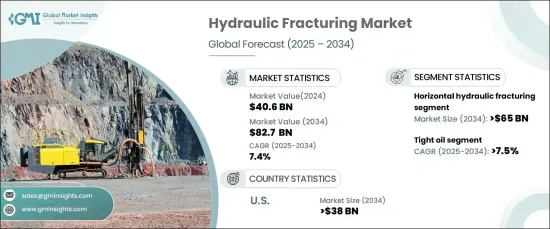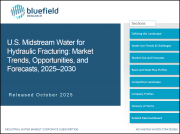
|
시장보고서
상품코드
1666616
수압 파쇄 시장 : 기회, 성장 촉진요인, 산업 동향 분석 및 예측(2025-2034년)Hydraulic Fracturing Market Opportunity, Growth Drivers, Industry Trend Analysis, and Forecast 2025 - 2034 |
||||||
세계의 수압 파쇄 시장은 2024년에 406억 달러로 평가되었으며 2025년부터 2034년에 걸쳐 CAGR 7.4%를 나타낼 것으로 예측됩니다.
산업 및 상업 운영을 포함한 다양한 부문에서 에너지 수요가 증가하면서 시장의 확장을 주도하고 있습니다. 또한 셰일 가스층, 석탄층 메탄, 타이트 오일 매장량과 같은 비전통적인 석유 및 가스 자원을 활용하는 것에 대한 중요성이 점점 더 강조되고 있습니다. 이러한 자원은 효율적인 추출을 위해 첨단 수압 파쇄 기술이 필요하며, 이는 시장 성장을 더욱 촉진합니다. 시추 및 추출 기술의 지속적인 발전과 새로운 추출 현장 개발 및 기존 유정 최적화는 전 세계 에너지 수요를 충족하는 데 핵심적인 역할을 하고 있습니다.

수압 파쇄 기술이 발전함에 따라 기술 혁신으로 운영 효율성이 향상되고 있습니다. 석유 및 가스 부문의 기업들은 비전통 저류층에서 탄화수소를 추출하기 위해 최첨단 방법을 점점 더 많이 채택하고 있습니다. 특히 타이트 오일 및 셰일 가스 지층이 있는 지역에서 천연 가스와 석유에 대한 수요가 증가하면서 시장이 활성화될 것으로 예상됩니다. 또한 수압 파쇄 기술의 연구 개발에 대한 투자가 증가하고 인프라 개발과 에너지 자립에 대한 관심이 높아지면서 시장의 낙관적인 전망에 기여하고 있습니다.
| 시장 범위 | |
|---|---|
| 시작 연도 | 2024년 |
| 예측 연도 | 2025-2034년 |
| 시작 금액 | 406억 달러 |
| 예측 금액 | 827억 달러 |
| CAGR | 7.4% |
시장의 뚜렷한 트렌드 중 하나는 수평 수압 파쇄의 인기가 높아지고 있다는 점입니다. 이 기술은 2034년까지 650억 달러의 가치에 도달할 것으로 예상됩니다. 수평 파쇄는 단일 유정으로 더 넓은 표면적에 접근할 수 있기 때문에 비전통 저류층에서 탄화수소를 추출하는 데 매우 효과적입니다. 이 접근 방식은 기존의 수직 시추에 비해 효율적이기 때문에 셰일 개발 프로젝트에서 특히 인기가 높습니다. 생산 속도를 높이고 이전에는 도달할 수 없었던 천연가스 매장지에 접근할 수 있는 이 방법의 능력은 이 기술의 채택을 더욱 촉진할 것으로 예상됩니다.
타이트 오일 부문의 수압 파쇄 시장도 2034년까지 7.5% 이상의 연평균 성장률(CAGR)이 예상되는 등 크게 성장할 것으로 보입니다. 시추 및 파쇄 기술의 발전과 유가 상승 및 글로벌 수요 증가로 타이트 오일 추출의 수익성이 높아지고 있습니다. 인프라 투자와 국내 에너지 자립 추진에 따른 타이트 오일 생산의 지속적인 확대는 시장의 성장 궤도에 긍정적인 영향을 미치고 있습니다.
미국의 수압 파쇄 시장은 2034년까지 380억 달러를 넘어설 것으로 예상됩니다. 셰일 자원의 급속한 개발과 새로운 유전 및 가스전의 발견이 시장 확대에 박차를 가하고 있습니다. 주요 유전 서비스 기업들은 해외 에너지원에 대한 의존도를 줄이면서 증가하는 수요를 충족하기 위해 기술 역량을 향상하고 국내 생산을 강화하는 데 주력하고 있습니다.
목차
제1장 조사 방법과 조사 범위
- 시장의 정의
- 기본 추정과 계산
- 예측 계산
- 데이터 출처
- 1차 데이터
- 2차 데이터
- 유상
- 공적
제2장 주요 요약
제3장 업계 인사이트
- 생태계 분석
- 규제 상황
- 업계에 미치는 영향요인
- 성장 촉진요인
- 업계의 잠재적 위험 및 과제
- 성장 가능성 분석
- Porter's Five Forces 분석
- 공급기업의 협상력
- 구매자의 협상력
- 신규 참가업체의 위협
- 대체품의 위협
- PESTEL 분석
제4장 경쟁 구도
- 소개
- 전략 대시보드
- 혁신과 지속가능성의 전망
제5장 시장 규모와 예측 : 기술별(2021-2034년)
- 주요 동향
- 플러그와 퍼포레이션
- 슬라이딩 슬리브
제6장 시장 규모와 예측 : 유정별(2021-2034년)
- 주요 동향
- 수평
- 수직
제7장 시장 규모와 예측 : 용도별(2021-2034년)
- 주요 동향
- 원유
- 셰일 가스
- 타이트 가스
- 타이트 오일
- 기타
제8장 시장 규모와 예측 : 지역별(2021-2034년)
- 주요 동향
- 북미
- 미국
- 캐나다
- 멕시코
- 유럽
- 영국
- 러시아
- 노르웨이
- 아시아태평양
- 중국
- 브루나이
- 호주
- 인도네시아
- 중동 및 아프리카
- 사우디아라비아
- 오만
- 라틴아메리카
- 아르헨티나
제9장 기업 프로파일
- Baker Hughes
- Calfrac
- Evolution
- Halliburton
- Liberty
- National Energy Services
- NexTier
- NOV
- ProFrac
- Schlumberger
- Shell
- Tacrom
- TechnipFMC
- Trican
- Weatherford
The Global Hydraulic Fracturing Market was valued at USD 40.6 billion in 2024 and is projected to grow at a CAGR of 7.4% from 2025 to 2034. The rising energy demand across various sectors, including industrial and commercial operations, is driving the market's expansion. In addition, there is a growing emphasis on tapping into unconventional oil and gas resources, such as shale gas formations, coal bed methane, and tight oil reserves. These resources require advanced hydraulic fracturing technologies to ensure efficient extraction, further fueling market growth. Continuous advancements in drilling and extraction technologies, coupled with the development of new extraction sites and optimizing existing wells, are playing a key role in meeting the global energy demand.

As hydraulic fracturing techniques evolve, technological innovations are enhancing operational efficiency. Companies in the oil and gas sector are increasingly adopting state-of-the-art methods for extracting hydrocarbons from unconventional reservoirs. The rise in demand for natural gas and oil, especially in areas with tight oil and shale gas formations, is expected to boost the market. Additionally, rising investments in research and development of hydraulic fracturing technologies, infrastructure development, and a stronger focus on energy independence are contributing to the market's optimistic outlook.
| Market Scope | |
|---|---|
| Start Year | 2024 |
| Forecast Year | 2025-2034 |
| Start Value | $40.6 Billion |
| Forecast Value | $82.7 Billion |
| CAGR | 7.4% |
One of the prominent trends in the market is the growing popularity of horizontal hydraulic fracturing. This technique is anticipated to reach a value of USD 65 billion by 2034. Horizontal fracturing is highly effective in extracting hydrocarbons from unconventional reservoirs as it allows operators to access a larger surface area with a single well. This approach is more efficient compared to traditional vertical drilling, making it particularly popular in shale development projects. The method's ability to enhance production rates and access previously unreachable natural gas deposits is expected to further drive its adoption.
The hydraulic fracturing market within the tight oil sector is also poised for significant growth, with an expected CAGR of over 7.5% through 2034. The advancement of drilling and fracturing technologies, along with rising oil prices and strong global demand, are making tight oil extraction more profitable. The continued expansion of tight oil production, driven by infrastructure investments and the push for domestic energy independence, is positively influencing the market's growth trajectory.
The hydraulic fracturing market in the U.S. is set to surpass USD 38 billion by 2034. The rapid development of shale resources, coupled with the discovery of new oil and gas fields, is fueling the market's expansion. Major oilfield service companies are focusing on improving their technical capabilities and enhancing domestic production to meet increasing demand while reducing reliance on foreign energy sources.
Table of Contents
Chapter 1 Methodology & Scope
- 1.1 Market definitions
- 1.2 Base estimates & calculations
- 1.3 Forecast calculation
- 1.4 Data sources
- 1.4.1 Primary
- 1.4.2 Secondary
- 1.4.2.1 Paid
- 1.4.2.2 Public
Chapter 2 Executive Summary
- 2.1 Industry synopsis, 2021 - 2034
Chapter 3 Industry Insights
- 3.1 Industry ecosystem analysis
- 3.2 Regulatory landscape
- 3.3 Industry impact forces
- 3.3.1 Growth drivers
- 3.3.2 Industry pitfalls & challenges
- 3.4 Growth potential analysis
- 3.5 Porter's analysis
- 3.5.1 Bargaining power of suppliers
- 3.5.2 Bargaining power of buyers
- 3.5.3 Threat of new entrants
- 3.5.4 Threat of substitutes
- 3.6 PESTEL analysis
Chapter 4 Competitive Landscape, 2024
- 4.1 Introduction
- 4.2 Strategic dashboard
- 4.3 Innovation & sustainability landscape
Chapter 5 Market Size and Forecast, By Technology, 2021 – 2034 (USD Million)
- 5.1 Key trends
- 5.2 Plug and perforation
- 5.3 Sliding sleeves
Chapter 6 Market Size and Forecast, By Well, 2021 – 2034 (USD Million)
- 6.1 Key trends
- 6.2 Horizontal
- 6.3 Vertical
Chapter 7 Market Size and Forecast, By Application, 2021 – 2034 (USD Million)
- 7.1 Key trends
- 7.2 Crude oil
- 7.3 Shale gas
- 7.4 Tight gas
- 7.5 Tight oil
- 7.6 Others
Chapter 8 Market Size and Forecast, By Region, 2021 – 2034 (USD Million)
- 8.1 Key trends
- 8.2 North America
- 8.2.1 U.S
- 8.2.2 Canada
- 8.2.3 Mexico
- 8.3 Europe
- 8.3.1 UK
- 8.3.2 Russia
- 8.3.3 Norway
- 8.4 Asia Pacific
- 8.4.1 China
- 8.4.2 Brunei
- 8.4.3 Australia
- 8.4.4 Indonesia
- 8.5 Middle East & Africa
- 8.5.1 Saudi Arabia
- 8.5.2 Oman
- 8.6 Latin America
- 8.6.1 Argentina
Chapter 9 Company Profiles
- 9.1 Baker Hughes
- 9.2 Calfrac
- 9.3 Evolution
- 9.4 Halliburton
- 9.5 Liberty
- 9.6 National Energy Services
- 9.7 NexTier
- 9.8 NOV
- 9.9 ProFrac
- 9.10 Schlumberger
- 9.11 Shell
- 9.12 Tacrom
- 9.13 TechnipFMC
- 9.14 Trican
- 9.15 Weatherford




















